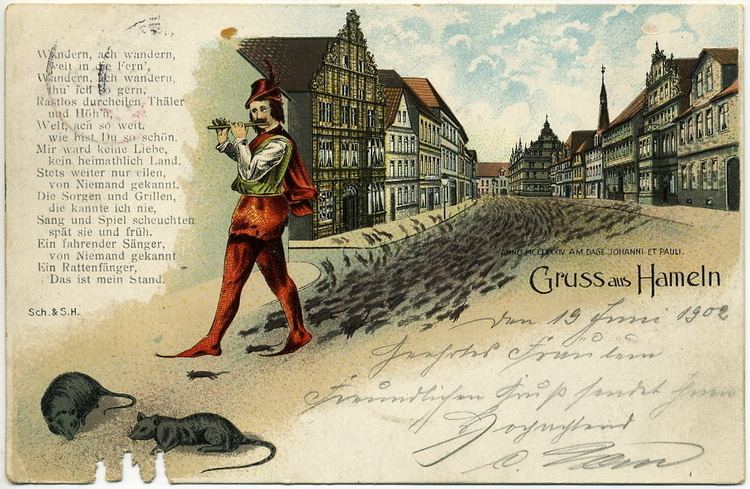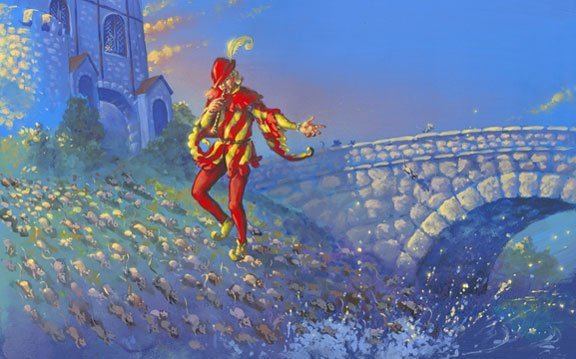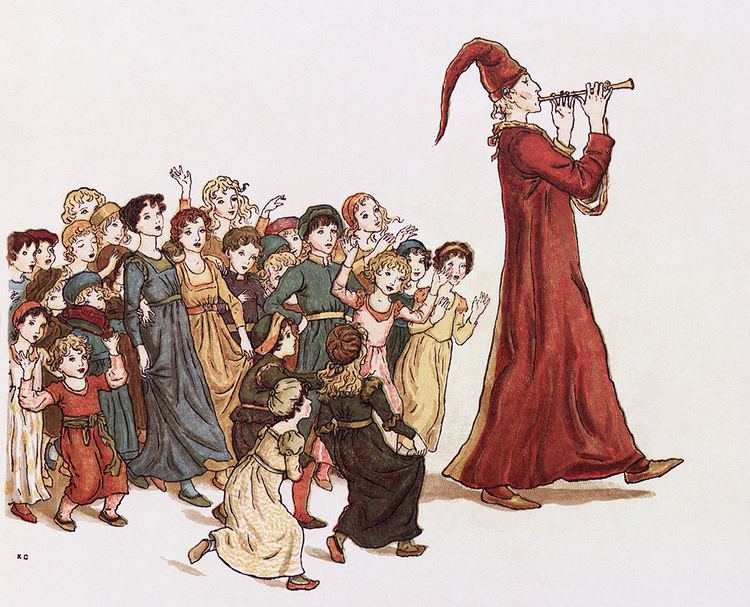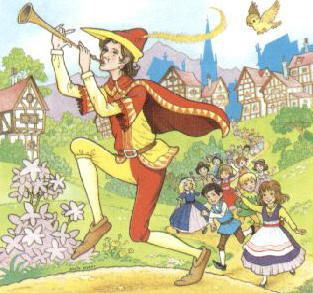 | ||
The pied piper of hamelin fairy tales for kids traditional story
The Pied Piper of Hamelin (German: Rattenfänger von Hameln also known as the Pan Piper, the Rat-Catcher of Hamelin) is the subject character of a legend from the town of Hamelin (Hameln), Lower Saxony, Germany. The legend dates back to the Middle Ages, the earliest references describing a piper, dressed in multicolored ("pied") clothing, who was a rat-catcher hired by the town to lure rats away with his magic pipe. When the citizens refuse to pay for this service, he retaliates by using his instrument's magical power on their children, leading them away as he had the rats. This version of the story spread as folklore and has appeared in the writings of Johann Wolfgang von Goethe, the Brothers Grimm, and Robert Browning, among others.
Contents
- The pied piper of hamelin fairy tales for kids traditional story
- Pied piper of hamelin bedtime story bedtimestory tv
- Plots
- History
- Natural causes
- Emigration theory
- Fourteenth century Decan Lude chorus book
- Fifteenth century Lneburg manuscript
- Sixteenth and seventeenth century sources
- Adaptations
- As metaphor
- Allusions in linguistics
- Present day Hamelin and The Pied Piper in modern times
- References

There are many contradictory theories about the Pied Piper. Some have been proposed suggesting he was a symbol of hope to the people of Hamelin, which had been attacked by plague; he moved all the rats out from the town of Hamelin, thus saving the people from the epidemic disease.

The earliest known record of this story is from the town of Hamelin itself, depicted in a stained glass window created for the church of Hamelin, which dates to around 1300. Although it was destroyed in 1660, several written accounts have survived.

Pied piper of hamelin bedtime story bedtimestory tv
Plots

In 1284, while the town of Hamelin was suffering from a rat infestation, a piper dressed in multicolored clothing appeared, claiming to be a rat-catcher. He promised the mayor a solution to their problem with the rats. The mayor, in turn, promised to pay him for the removal of the rats. (According to some versions of the story, the promised sum was 1000 guilders.) The piper accepted and played his pipe to lure the rats into the Weser River, where all but one drowned.
Despite the piper's success, the mayor reneged on his promise and refused to pay him the full sum (reputedly reduced to a sum of 50 guilders) even going so far as to hint that he brought the rats himself in an extortion attempt. The piper left the town angrily, vowing to return later to take revenge. On Saint John and Paul's day, while the Hamelinites were in church, the piper returned dressed in green like a hunter playing his pipe. In so doing, he attracted the town's children. One hundred and thirty children followed him out of town and into a cave and were never seen again. Depending on the version, at most three children remained behind: one was lame and could not follow quickly enough, the second was deaf and therefore could not hear the music, and the last was blind and unable to see where he was going. These three informed the villagers of what had happened when they came out from church.
Other versions relate that the Pied Piper led the children to the top of Koppelberg Hill, where he took them to a beautiful land and had his wicked way, or a place called Koppenberg Mountain, or Transylvania, or that he made them walk into the Weser as he did with the rats, and they all drowned. Some versions state that the Piper returned the children after payment, or that he returned the children after the villagers paid several times the original amount of gold.
History
The earliest mention of the story seems to have been on a stained-glass window placed in the Church of Hamelin c. 1300. The window was described in several accounts between the 14th and 17th centuries. It was destroyed in 1660. Based on the surviving descriptions, a modern reconstruction of the window has been created by historian Hans Dobbertin. It features the colorful figure of the Pied Piper and several figures of children dressed in white.
This window is generally considered to have been created in memory of a tragic historical event for the town. Also, Hamelin town records start with this event. The earliest written record is from the town chronicles in an entry from 1384 which states: "It is 100 years since our children left."
Although research has been conducted for centuries, no explanation for the historical event is universally accepted as true. In any case, the rats were first added to the story in a version from c. 1559 and are absent from earlier accounts.
Natural causes
A number of theories suggest that children died of some natural causes such as disease or starvation and that the Piper was a symbolic figure of Death. Analogous themes which are associated with this theory include the Dance of Death, Totentanz or Danse Macabre, a common medieval trope. Some of the scenarios that have been suggested as fitting this theory include that the children drowned in the river Weser, were killed in a landslide or contracted some disease during an epidemic. Another modern interpretation reads the story as alluding to an event where Hamelin children were lured away by a pagan or heretic sect to forests near Coppenbrügge (the mysterious Koppen "hills" of the poem) for ritual dancing where they all perished during a sudden landslide or collapsing sinkhole.
Some theories have linked the disappearance of the children to Mass Psychogenic Illness in the form of Dancing mania. Dancing mania outbreaks occurred during the 13th century, including one in 1237 in which a large group of children travelled from Erfurt to Arnstadt (about 20 km), jumping and dancing all the way,Marks, Robert W. (2005). The Story of Hypnotism. Kessinger Publishing. ISBN 978-1-4191-5424-9. in marked similarity to the legend of the Pied Piper of Hamelin, which originated at around the same time.
Others have suggested that the children left Hamelin to be part of a pilgrimage, a military campaign, or even a new Children's crusade (which is said to have occurred in 1212) but never returned to their parents. These theories see the unnamed Piper as their leader or a recruiting agent. The townspeople made up this story (instead of recording the facts) to avoid the wrath of the church or the king.
William Manchester's A World Lit Only by Fire places the events in 1484, 100 years after the written mention in the town chronicles that "It is 100 years since our children left", and further proposes that the Pied Piper was a psychopathic paedophile. Although for the time period it is highly improbable that one man could abduct so many children undetected. Furthermore, nowhere in the book does Manchester offer proof of his description of the facts as he presents them. He makes similar assertions regarding other legends, also without supporting evidence.
Emigration theory
Added speculation on the migration is based on the idea that by the 13th century the area had too many people resulting in the oldest son owning all the land and power (majorat), leaving the rest as serfs. It has also been suggested that one reason the emigration of the children was never documented was that the children were sold to a recruiter from the Baltic region of Eastern Europe, a practice that was not uncommon at the time. In her essay "Pied Piper Revisited", Sheila Harty states that surnames from the region settled are similar to those from Hamelin and that selling off illegitimate children, orphans or other children the town could not support is the more likely explanation. She states further that this may account for the lack of records of the event in the town chronicles. In his book The Pied Piper: A Handbook, Wolfgang Mieder states that historical documents exist showing that people from the area including Hamelin did help settle parts of Transylvania. Transylvania had suffered under lengthy Mongol invasions of Central Europe, led by two grandsons of Genghis Khan and which date from around the time of the earliest appearance of the legend of the piper, the early 13th century.
In the version of the legend posted on the official website for the town of Hamelin, another aspect of the emigration theory is presented:
Among the various interpretations, reference to the colonization of East Europe starting from Low Germany is the most plausible one: The "Children of Hameln" would have been in those days citizens willing to emigrate being recruited by landowners to settle in Moravia, East Prussia, Pomerania or in the Teutonic Land. It is assumed that in past times all people of a town were referred to as "children of the town" or "town children" as is frequently done today. The "Legend of the children's Exodus" was later connected to the "Legend of expelling the rats". This most certainly refers to the rat plagues being a great threat in the medieval milling town and the more or less successful professional rat catchers.
This version states that "children" may simply have referred to residents of Hamelin who chose to emigrate and not necessarily referred to youths.
Historian Ursula Sautter, citing the work of linguist Jurgen Udolph, offers this hypothesis in support of the emigration theory:
"After the defeat of the Danes at the Battle of Bornhöved in 1227," explains Udolph, "the region south of the Baltic Sea, which was then inhabited by Slavs, became available for colonization by the Germans." The bishops and dukes of Pomerania, Brandenburg, Uckermark and Prignitz sent out glib "locators," medieval recruitment officers, offering rich rewards to those who were willing to move to the new lands. Thousands of young adults from Lower Saxony and Westphalia headed east. And as evidence, about a dozen Westphalian place names show up in this area. Indeed there are five villages called Hindenburg running in a straight line from Westphalia to Pomerania, as well as three eastern Spiegelbergs and a trail of etymology from Beverungen south of Hamelin to Beveringen northwest of Berlin to Beweringen in modern Poland.
Udolph favors the hypothesis that the Hamelin youths wound up in what is now Poland. Genealogist Dick Eastman cited Udolph's research on Hamelin surnames that have shown up in Polish phonebooks:
Linguistics professor Jurgen Udolph says that 130 children did vanish on a June day in the year 1284 from the German village of Hamelin (Hameln in German). Udolph entered all the known family names in the village at that time and then started searching for matches elsewhere. He found that the same surnames occur with amazing frequency in Priegnitz and Uckermark, both north of Berlin. He also found the same surnames in the former Pomeranian region, which is now a part of Poland.
Udolph surmises that the children were actually unemployed youths who had been sucked into the German drive to colonize its new settlements in Eastern Europe. The Pied Piper may never have existed as such, but, says the professor, "There were characters known as lokators who roamed northern Germany trying to recruit settlers for the East." Some of them were brightly dressed, and all were silver-tongued.
Professor Udolph can show that the Hamelin exodus should be linked with the Battle of Bornhoeved in 1227 which broke the Danish hold on Eastern Europe. That opened the way for German colonization, and by the latter part of the thirteenth century there were systematic attempts to bring able-bodied youths to Brandenburg and Pomerania. The settlement, according to the professor's name search, ended up near Starogard in what is now northwestern Poland. A village near Hamelin, for example, is called Beverungen and has an almost exact counterpart called Beveringen, near Pritzwalk, north of Berlin and another called Beweringen, near Starogard.
Local Polish telephone books list names that are not the typical Slavic names one would expect in that region. Instead, many of the names seem to be derived from German names that were common in the village of Hamelin in the thirteenth century. In fact, the names in today's Polish telephone directories include Hamel, Hamler and Hamelnikow, all apparently derived from the name of the original village.
Fourteenth-century Decan Lude chorus book
Decan Lude of Hamelin was reported c. 1384, to have in his possession a chorus book containing a Latin verse giving an eyewitness account of the event. The verse was reportedly written by his grandmother. This chorus book is believed to have been lost since the late 17th century. The odd-looking name 'Decan Lude' may possibly indicate a priest holding the position of Dean (Latin: decanus, modern German: Dekan or Dechant) whose name was Ludwig; but as yet he has proved impossible to trace.
Fifteenth-century Lüneburg manuscript
The Lüneburg manuscript (c. 1440–50) gives an early German account of the event, rendered in the following form in an inscription on a house in Hamelin:
anno 1284 am dage johannis et pauli war der 26. junidorch einen piper mit allerley farve bekledet gewesen cxxx kinder verledet binnen hameln geborento calvarie bi den koppen verloren(In the year 1284 on the day of [Saints] John and Paul on 26th June130 children born in Hamelin were led away by a piper [clothed] in many coloursto [their] Calvary near the Koppen, [and] lost)This appears to be the oldest surviving account. Koppen (High German Kuppe, meaning a knoll or domed hill) seems to be a reference to one of several hills surrounding Hamelin. Which of them was intended by the manuscript's author remains uncertain.
Sixteenth- and seventeenth-century sources
In 1556, De miraculis sui temporis (Latin: Concerning the Wonders of his Times) by Jobus Fincelius mentions the tale. The author identifies the Piper with the Devil.
Somewhere between 1559 and 1565, Count Froben Christoph von Zimmern included a version in his Zimmerische Chronik. This appears to be the earliest account which mentions the plague of rats. Von Zimmern dates the event only as "several hundred years ago" (vor etlichen hundert jarn [sic]), so that his version throws no light on the conflict of dates (see next paragraph). Another contemporary account is that of Johann Weyer in his De praestigiis daemonum (1563).
The earliest English account is that of Richard Rowland Verstegan (1548 – c. 1636), an antiquary and religious controversialist of partly Dutch descent, in his Restitution of Decayed Intelligence (Antwerp, 1605); he does not give his source. (It is unlikely to have been von Zimmern since his manuscript chronicle was not discovered until 1776.) Verstegan includes the reference to the rats and the idea that the lost children turned up in Transylvania. The phrase '"Pide [sic] Piper" occurs in his version and seems to have been coined by him. Curiously enough his date is entirely different from that given above 22 July 1376; this may suggest that two events, a migration in 1284 and a plague of rats in 1376, have become fused together.
The story is given, with a different date, in Robert Burton's The Anatomy of Melancholy of 1621, where it is used as an example of supernatural forces: 'At Hammel in Saxony, ann. 1484, 20 Junii, the devil, in likeness of a pied piper, carried away 130 children that were never after seen.' He does not give his immediate source.
Verstegan's account is repeated in William Ramesey's Helminthologia; or Some Physical Considerations of Wormes (1668)—"... that most remarkable story in Verstegan, of the Pied Piper, that carryed away a hundred and sixty Children from the Town of Hamel in Saxony, on the 22. of July, Anno Dom. 1376. A wonderful permission of GOD to the Rage of the Devil". Nathaniel Wanley's version (Wonders of the Little World, 1678, p. 598 – from Weyer) is not, as was formerly stated here, the immediate source for Robert Browning's poem (see Adaptations below); it follows the German tradition and gives the 1284 date.
Adaptations
• The short story "The Rat King" by John Connolly, first included in the 2016 edition of his novel The Book of Lost Things, is a fairly faithful adaptation of the legend, but with a new ending. It was adapted for BBC Radio 4 and first broadcast on 28 October 2016.
As metaphor
- a charismatic person who attracts followers
- a musician who attracts mass
- a leader who makes irresponsible promises
Allusions in linguistics
In linguistics, pied-piping is the common name for the ability of question words and relative pronouns to drag other words along with them when brought to the front, as part of the phenomenon called Wh-movement. For example, in "For whom are the pictures?", the word "for" is pied-piped by "whom" away from its declarative position ("The pictures are for me"), and in "The mayor, pictures of whom adorn his office walls" both words "pictures of" are pied-piped in front of the relative pronoun, which normally starts the relative clause.
Some researchers believe that the tale has inspired the common English phrase "pay the piper", although the phrase is actually a contraction of the English proverb "he who pays the piper calls the tune" which simply means that the person paying for something is the one who gets to say how it should be done.
Present-day Hamelin and The Pied Piper in modern times
The present-day City of Hamelin continues to maintain information about the Pied Piper legend and possible origins of the story on its website. Interest in the city's connection to the story remains so strong that in 2009, Hamelin held a tourist festival to mark the 725th anniversary of the disappearance of the town's earlier children. The eerie nature of such a celebration was enough to warrant an article in the Fortean Times, a print magazine devoted to odd occurrences, legends, cryptozoology and all things strange which are known now as Forteana The article noted that even to this day, there is prohibition against playing music or dancing upon the Bungelosenstrasse ("street without drums"), the street where the children were purported to have last been seen before they disappeared or left the town. There is even a building, popular with visitors, that is called "the rat catcher's house" although it bears no connection to the Rat-Catcher version of the legend. Indeed, the Rattenfängerhaus is instead, associated with the story due to the earlier inscription upon its facade mentioning the legend. The house was built much later in 1602 and 1603. It is now a Hamelin City-owned restaurant with a pied piper theme throughout. The city also maintains an online shop with rat-themed merchandise as well as offering an officially licensed Hamelin Edition of the popular board game Monopoly which depicts the legendary Piper on the cover.
In addition to the recent milestone festival, each year the city marks June 26 as "Rat Catcher's Day". In the United States, a similar holiday for Exterminators based on Rat Catcher's Day has failed to catch on and is marked on July 22.
